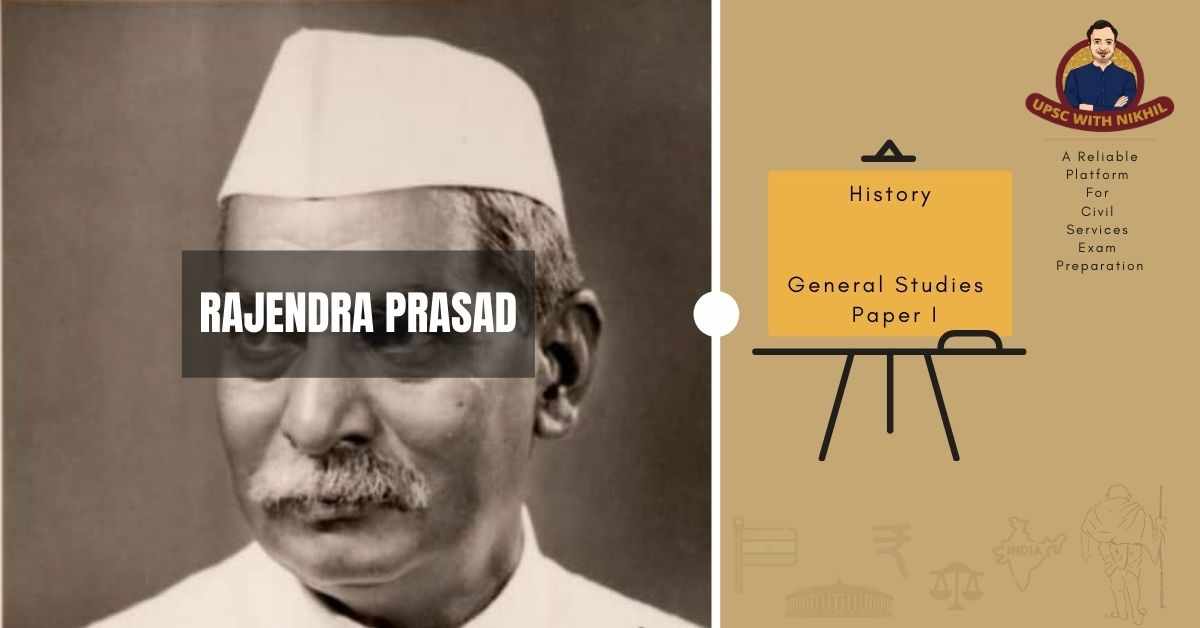Dr Rajendra Prasad
Dr. Rajendra Prasad was the first president of independent India. He was one of the prominent leaders of the Indian National Movement. He gave up his profession of law for the freedom struggle. He was an Indian Freedom Activist, Lawyer, Scholar too. He was from the region of Bihar, a supporter of Mahatma Gandhi. He also served as the Food and Agriculture Minister in the central government after 1946 elections. He also served as the President of the Constituent Assembly of India.
• Born on 3rd December 1884 in Zeradai, District Siwan in Bihar to Father Mahadev Sahai, who was a scholar of Persian and Sanskrit and Mother Kamleshwari Devi, a pious lady.
• Raised in a modest landowning family.
• He received elementary education from a tutor and then studied at Chapra District School.
• He later studied at University of Calcutta after winning a scholarship and joined the Presidency College in Calcutta.
• He graduated with MA(Economics) in 1907 and joined Dawn Society and Servants of India Society.
• He worked as a teacher in Langat Singh College, Muzaffarpur, Bihar after completing his MA and later became its principal.
• He left the job in 1909 and came to Calcutta to pursue a degree in law.
• Dr. Prasad won a doctorate in law from Allahabad University.
• He started his legal career in 1916 in Patna High Court and founded the Bihar Law Weekly.
INDIAN NATIONAL MOVEMENT
• Dr. Prasad attended the 1906 Calcutta session of Indian National Congress.
• He joined the party in 1911 and later elected to the All India Congress Committee after which he met Mahatma Gandhi.
• He was highly impressed by Mahatma Gandhi and he supported Gandhi during the Satyagrah Movement againt Indigo Planters in Champaran, Bihar.
• He later quit his lucrative career as a lawyer in 1920 and jumped into Freedom Struggle Movement and participated in the Non-Cooperation Movement.


• He led the Non-Cooperation Movement in Bihar holding meetings, touring state and making speeches.
• He urged people to boycott government schools, colleges, jobs.
• He also started the National College in Patna in 1921 to promote Swadeshi asking people to boycott foreign goods.
• He even asked his son, Mrityunjaya Prasad, to drop out of his studies and enrol in Bihar Vidyapeeth, an institution founded by him and along with his colleagues on the traditional Indian model.
• He took an active part in rehabilitation work after 1914 floods and 1934 earthquake in Bihar. He was released 2 days after the earthquake and then he formed Bihar Central Relief Committee.
• He also set up the Quetta Central Relief Committee in Sindh and Punjab under his own presidency after 1935 Quetta Earthquake.
• Dr. Prasad was elected as the President of the Bombay Session of the Indian National Congress in October 1934.
• He was also elected as the President for second time in 1939 after Subhash Chandra Bose resigned from his post and third time President of INC in 1947 when J.B.Kripalani resigned from his post.
• He also worked as a journalist in the national interest and wrote for Searchlight in English and founded and edited the Hindi weekly Desh and collected funds for these papers.
• He also started his longlife campaign to establish Hindi as the national language.
• Dr. Prasad was arrested several times during the national struggle and imprisoned by British authorities during the Salt Satyagraha of 1931 and the Quit India Movement of 1942.
• He was very much active in Quit India Movement in 1942 and led protests, demonstrations in Bihar.
• He was arrested in Sadaqat Ashram, Patna and sent to Bankipur Central Jail in 1942 and he was released after 3 years in 1945.
• Dr. Prasad was selected as the Food and Agriculture Minister in the interim government headed by Jawaharlal Nehru in 1946.
• He was also elected as the President of the Constituent Assembly on 11 December, 1946 and presided over constituent assembly from 1946 to 1949.
• He was also the chairman of the four committees of constituent assembly.
• After Constitution of India was ratified, Dr. Prasad was chosen to be India’s first President.
• He was re-elected for two consecutive terms in 1952 and 1957, and is the only president to do so.
• The opening of Mughal Gardens of Rashtrapati Bhawan for a month to public started during his tenure.
• He also got into tussle with then Prime Minister Jawaharlal Nehru over Hindu Code Bill as Dr. Prasad wanted Uniform Civil Code to be implemented but Nehru wanted to give minority some protection and some extra benefits.
• He was also in the favour of rebuilding the Somnath Temple whereas Nehru opposed it.
• After serving 12 years as President of India he retired in May, 1962 and returned to Patna, Bihar and preferred to stay in the campus of Bihar Vidyapeeth.
• He was awarded Bharat Ratna in 1962 for his contribution as a leader of the Indian National Congress and as President of India.
• His wife Rajavanshi Devi died in September, 1962 and months later he also died in February, 1963 aged 78.
LITERARY WORKS
• Satyagraha at Champaran (1922)
• India Divided (1946)
• Atmakatha (1946) his autobiography written during his 3 year prison term in Bankipur Jail
• Mahatma Gandhi and Bihar, Some Reminiscences (1949)
• Bapu Ke Kadmon Mein (1954)
• Since Independence (1960)


